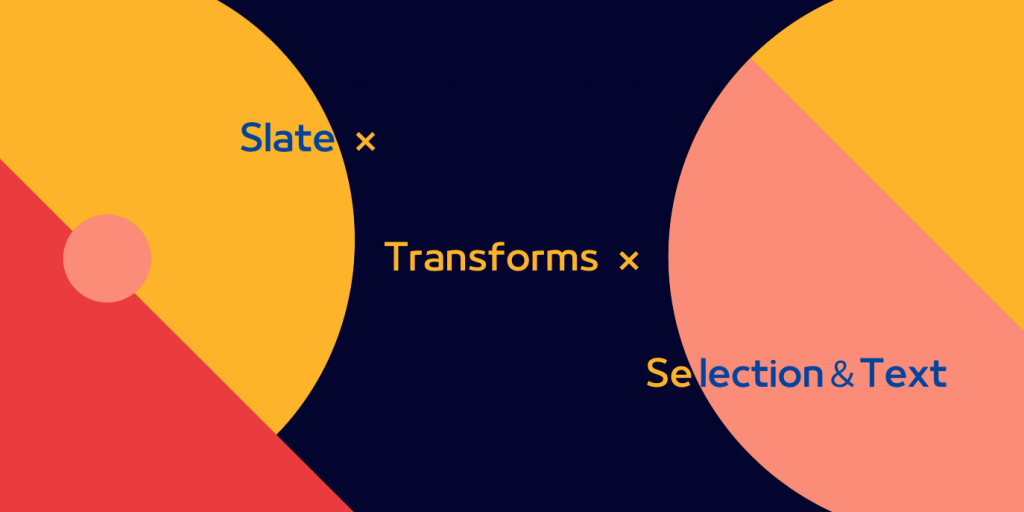Day 29. slate × Transforms × Selection & Text

上一篇我们统整了 NodeTransforms 里各个 methods 的用法以及参数介绍, 传送门 在此~
这一篇同样会以 reference 的形式统整 SelectionTransforms 以及 TextTransforms 的功用以及传入参数的用途。
SelectionTransforms
collapse
-
用途:收合编辑器
selection -
参数:
-
editor: Editor -
options: CollapseOptions
-
-
options :
interface CollapseOptions { edge?: 'anchor' | 'focus' | 'start' | 'end' }-
edge决定
selection要往哪一个 Point 收合:-
'anchor'往
selection的anchorpoint 收合 -
'focus'往
selection的focuspoint 收合 -
'start'会搭配
Range.edges以及Range.isBackwardmethod 判断 selection 是否为『反向的』并得出真正的起始、结束位置并往相对起始的 point 收合
-
'end'会搭配
Range.edges以及Range.isBackwardmethod 判断 selection 是否为『反向的』并得出真正的起始、结束位置并往相对结束的 point 收合
-
-
deselect
- 用途:取消设置编辑器的
selectionvalue - 参数:
-
editor: Editor
-
里头的程序码很基本,就是直接呼叫 'set_selection' Operation
/**
* Unset the selection.
*/
deselect(editor: Editor): void {
const { selection } = editor
if (selection) {
editor.apply({
type: 'set_selection',
properties: selection,
newProperties: null,
})
}
},
move
-
用途:向前或向後移动
selection里头的 points 。 -
参数:
-
editor: Editor -
options: MoveOptions
-
-
options :
interface MoveOptions { distance?: number unit?: 'offset' | 'character' | 'word' | 'line' reverse?: boolean edge?: 'anchor' | 'focus' | 'start' | 'end' }-
distance搭配
unit(单位)决定一次要移动的实际距离 -
unit移动的单位,分为
'offset'、'character'、'word'、'line'。关於不同的单位实作的细节被集中在Editor.positions里,包含它的演算法也都被作者 comment 在 method 里。因为太过细节了这边就不详细解说,再请有兴趣的读者自行上前查看。 -
reverse决定 points 移动的方向:
-
reverse: true:向前移动 -
reverse: false:向後移动
-
-
edge决定要移动的
selectionpoint ,分为:-
'anchor'只移动
anchorpoint -
'focus'只移动
focuspoint -
'start'会搭配
Range.isBackwardmethod 判断selection是否为『反向的』,将相对起始的 point ('anchor' | 'focus') assign 给edge -
'end'会搭配
Range.isBackwardmethod 判断selection是否为『反向的』,将相对结束的 point ('anchor' | 'focus') assign 给edge
edge的预设值为null,这会同时移动anchor与focuspoint -
-
select
- 用途:重新设定编辑器的
selectionvalue - 参数:
-
editor: Editor -
target: Location
-
这里头的程序码也很基本:
-
包含确保的
target为 Range typetarget = Editor.range(editor, target) -
更新
selection属性const { selection } = editor if (selection) { Transforms.setSelection(editor, target) return } -
抛出例外状况
if (!Range.isRange(target)) { throw new Error( `When setting the selection and the current selection is \`null\` you must provide at least an \`anchor\` and \`focus\`, but you passed: ${JSON.stringify( target )}` ) } -
执行 Operation
editor.apply({ type: 'set_selection', properties: selection, newProperties: target, })
setPoint
-
用途:对编辑器
selection的其中一个 Point 设定新的props属性 -
参数:
-
editor: Editor -
props: Partial<Point> -
options: SetPointOptions
-
-
options :
interface SetPointOptions { edge?: 'anchor' | 'focus' | 'start' | 'end' }-
edge决定要将
props取得的属性设定於selection的哪一个 Point-
'anchor'将
props设定於anchorpoint 上 -
'focus'将
props设定於focuspoint 上 -
'start'会搭配
Range.edges以及Range.isBackwardmethod 判断 selection 是否为『反向的』并得出真正的起始、结束位置并将 props 设定於相对起始的
point上 -
'end'会搭配
Range.edges以及Range.isBackwardmethod 判断 selection 是否为『反向的』并得出真正的起始、结束位置。并将 props 设定於相对结束的
point上。
-
-
setSelection
- 用途:设定新的
props属性在编辑器的selection上 - 参数:
-
editor: Editor -
props: Partial<Range>
-
除了设定 custom 属性之外,它也同时确保不会将 selection 里的 anchor 或 focus point 设为 null
for (const k in props) {
if (
(k === 'anchor' &&
props.anchor != null &&
!Point.equals(props.anchor, selection.anchor)) ||
(k === 'focus' &&
props.focus != null &&
!Point.equals(props.focus, selection.focus)) ||
(k !== 'anchor' && k !== 'focus' && props[k] !== selection[k])
) {
oldProps[k] = selection[k]
newProps[k] = props[k]
}
}
TextTransforms
delete
-
用途:移除编辑器内的文字内容
-
参数:
-
editor: Editor -
options: DeleteOptions
-
-
options :
interface DeleteOptions { at?: Location distance?: number unit?: 'character' | 'word' | 'line' | 'block' reverse?: boolean hanging?: boolean voids?: boolean }-
at欲删除的文字内容於编辑器里的位置,分为三种删除情形:
-
at传入一组Path→ 将整个节点删除 -
at传入一组Range→ 将Range集合的文字内容删除 -
at传入一个Point→ 搭配distance与unit决定要从该Point向前删除多少文字内容
-
-
distance搭配
unit(单位)决定一次要移动的实际距离 -
unit移动的单位,分为
'offset'、'character'、'word'、'line'。关於不同的单位实作的细节被集中在Editor.positions里,包含它的演算法也都被作者 comment 在 method 里。因为太过细节了这边就不详细解说,再请有兴趣的读者自行上前查看。 -
reverse如果传入的
at为Point的话,reverse会决定节点的删除方向-
reverse: true:向前删除 -
reverse: false:向後删除
-
-
hanging这个 value 会决定 Range 是否要另外修正为
unhangingtype 。hanging 在 Slate 里头的意思代表『这段 Range 涵盖到了不存在的节点』。
我们假设目前的 Slate Document 如下:
[{text: 'one '}, {text: 'two', bold: true}, {text: ' three'}]这时使用者看到的显示方式应该如下:
one two three
假设使用者选取了 "two" ,此时的
selection会有几种anchor与focuspoints 的可能性出现// 1 -- no hanging { anchor: { path: [1], offset: 0 }, focus: { path: [1], offset: 3 } } // 2 -- anchor hanging { anchor: { path: [0], offset: 4 }, focus: { path: [1], offset: 3 } } // 3 -- focus hanging { anchor: { path: [1], offset: 0 }, focus: { path: [2], offset: 0 } } // 4 -- both hanging { anchor: { path: [0], offset: 4 }, focus: { path: [2], offset: 0 } }当我们传入
hanging: false时, Slate 就会将这组 Range 传入Editor.unhangRangemethod 里确保 Range 维持在第一种情形。 -
voids决定在这个 Transform method 有呼叫到的所有操作行为中,是否要略过或避开 void nodes 的出现 。
-
这个 method 也有处理跨节点相关的情境,笔者这边暂且不多做介绍,未来有机会再追加补充。
insertFragment
-
用途:插入一组 Fragment 进指定的
atLocation 里 -
参数:
-
editor: Editor -
fragment: Node[] -
options: InsertFragmentOptions
-
-
options :
interface InsertFragmentOptions { at?: Location hanging?: boolean voids?: boolean }-
at要插入 Fragment nodes 的位置,分为三种插入情形:
-
at传入一组Path→ 将 Fragments 插入进节点的开头位置 -
at传入一组Range→ 将Range集合的文字内容移除後插入 Fragments -
at传入一个Point→ 直接将 Fragments 插入进该Point之後
-
-
hanging如果传入的
at为 Range type ,则这个 value 会决定 Range 是否要另外修正为unhangingtype 。详细的解释请参照上方的
DeleteOptions -
voids决定在这个 Transform method 有呼叫到的所有操作行为中,是否要略过或避开 void nodes 的出现 。
-
insertText
-
用途:插入一段文字字串进编辑器里
-
参数:
-
editor: Editor -
text: string -
options: InsertTextOptions
-
-
options :
interface InsertTextoptions { at?: Location voids?: boolean }-
at欲将文字插入於编辑器中的位置,分为三种输入情形:
-
at传入一组Path→ 将整个节点的文字内容修改为新输入的内容 -
at传入一组Range→ 将Range集合的文字内容修改为新输入的内容 -
at传入一个Point→ 直接将新输入的内容插入进该Point之後
-
-
void
一组布林值,决定文字插入的节点所属的 branch 的上层祖先节点能否有 void node 存在。
-
Day 03 HTML<列表标签>
列表标签可以用来为页面进行布局 主要分为无序列表、有序列表、自定义列表三大类 1.无序列表 无序列表...
【Android-Span】 设置TextView特定位置颜色+插入图片!
Span可以做到的事情有很多,如 -更改特定位置的字体颜色/大小 -新增项目符号 -可点击 -换行等...
D26 将config等等隐密资讯另外放置 - yaml
将重要资讯放到yaml内 config.yaml(放在BASE_DIR) --- email: EM...
卡夫卡的藏书阁【Book27】- Kafka - KafkaJS Admin 4
“They say ignorance is bliss.... they're wrong ” ...
Day 8 : 字串处理
字串处理感觉满多东西可以讲的,这次就讲讲我平时会用到的一些简易功能好了: 字串的大小写处理 pyth...